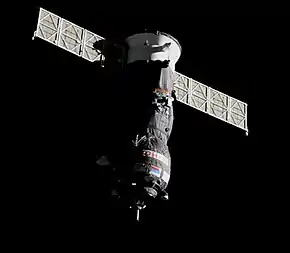Progress MS-17
Progress MS-17 (Russian: Прогресс МC-17), Russian production No. 446, identified by NASA as Progress 78P, is a planned Progress spacecraft to be launched by Roscosmos to resupply the International Space Station (ISS). This will be the 169th flight of a Progress spacecraft.
 Docking of Progress 76P | |
| Names | Progress-78P |
|---|---|
| Mission type | ISS resupply |
| Operator | Roscosmos |
| Spacecraft properties | |
| Spacecraft | Progress MS-17 |
| Spacecraft type | Progress-MS |
| Manufacturer | Energia |
| Launch mass | 7000 kg |
| Start of mission | |
| Launch date | July 2021 (planned) [1] |
| Rocket | Soyuz-2.1a |
| Launch site | Baikonur, Site 31 |
| Contractor | Progress Rocket Space Centre |
| End of mission | |
| Disposal | Deorbited (planned) |
| Decay date | 2021 (planned) |
| Orbital parameters | |
| Reference system | Geocentric orbit |
| Regime | Low Earth orbit |
| Inclination | 51.65° |
| Docking with ISS | |
Progress ISS Resupply | |
History
The Progress-MS is a uncrewed freighter based on the Progress-M featuring improved avionics. This improved variant first launched on 21 December 2015. It has the following improvements:[2][3][4][5]
- New external compartment that enables it to deploy satellites. Each compartment can hold up to four launch containers. First time installed on Progress MS-03.
- Enhanced redundancy thanks to the addition of a backup system of electrical motors for the docking and sealing mechanism.
- Improved Micrometeoroid (MMOD) protection with additional panels in the cargo compartment.
- Luch Russian relay satellites link capabilities enable telemetry and control even when not in direct view of ground radio stations.
- GNSS autonomous navigation enables real time determination of the status vector and orbital parameters dispensing with the need of ground station orbit determination.
- Real time relative navigation thanks to direct radio data exchange capabilities with the space station.
- New digital radio that enables enhanced TV camera view for the docking operations.
- The Ukrainian Chezara Kvant-V on board radio system and antenna/feeder system has been replaced with a Unified Command Telemetry System (UCTS).
- Replacement of the Kurs A with Kurs NA digital system.
Launch
A Soyuz-2.1a will launch Progress MS-17 to the International Space Station from Baikonur Site 31 July 2021 on a fast-track trajectory.[1] Around 3 hours 20 minutes after the launch, Progress MS-17 will automatically dock to Russian Orbital Segment (ROS) of ISS, where it is expected to remain until late 2021.
Expansion of Russian Orbital Segment
.jpg.webp)
According to the Roscosmos August 2020 plan, Progress MS-17 will initially dock to the aft port of the Zvezda Service Module (SM). If the Nauka module arrives at the station in July 2021 (as planned), Progress MS-17 would be re-docked to the nadir (Earth-facing) port of the newly arrived Nauka at the end of July 2021. The move will allow Roskosmos to prepare for the next step in the expansion of the Russian Orbital Segment, this time with the UM Prichal node module. Upon the launch of Prichal (Progress M-UM), currently scheduled for 24 November 2021, the Progress MS-17 will be undocked from Nauka's nadir port, carrying with it a special extension on Nauka's docking mechanism, which was custom-designed for cargo ships and crew vehicles. As a result, the UM Prichal module with its active hybrid docking port will then be able to dock to the reconfigured port on Nauka on 24 November 2021. This will provide a wider module passageway than was available through the adapter, which will be discarded with Progress MS-17.
If everything goes according to the August 2020 plan, Progress MS-17 will log 179 days in space.[6]
Cargo
The Progress MS-17 spacecraft is loaded with 0 kg (0 lb) of cargo, with 0 kg (0 lb) of this being dry cargo.
- Dry cargo: 0 kg (0 lb)
- Fuel: 0 kg (0 lb)
- Oxygen: 0 kg (0 lb)
- Water: 0 kg (0 lb)
Undocking and decay
The Progress MS-17 is scheduled to remain docked at the station through late 2021, when it will depart with trash and re-enter the Earth's atmosphere for destruction over the South Pacific Ocean.
References
- "Launch Schedule - Progress 78P". Spaceflight Now. 1 December 2020. Retrieved 2 December 2020.
- Krebs, Gunter (1 December 2015). "Progress-MS 01-19". Gunter's Space Page. Retrieved 3 October 2020.
- "Progress MS-17". NSSDCA. NASA. 14 May 2020. Retrieved 3 October 2020.
 This article incorporates text from this source, which is in the public domain.
This article incorporates text from this source, which is in the public domain. - Zak, Anatoly. "Progress-MS". RussianSpaceWeb. Retrieved 3 October 2020.
- Blau, Patrick (1 December 2015). "Progress MS Spacecraft". Spaceflight101. Retrieved 17 November 2020.
- Zak, Anatoly (10 October 2020). "Planned Russian space missions in 2021". RussianSpaceWeb. Retrieved 13 October 2020.
